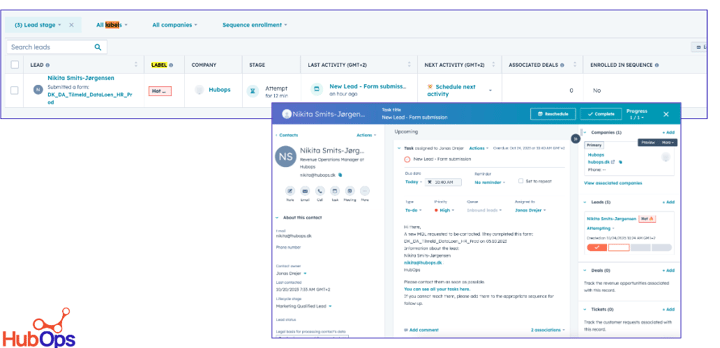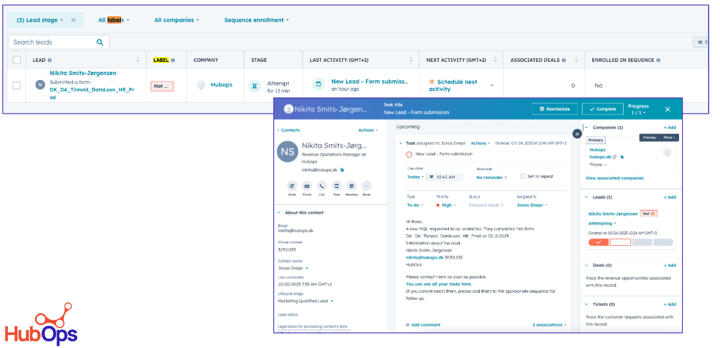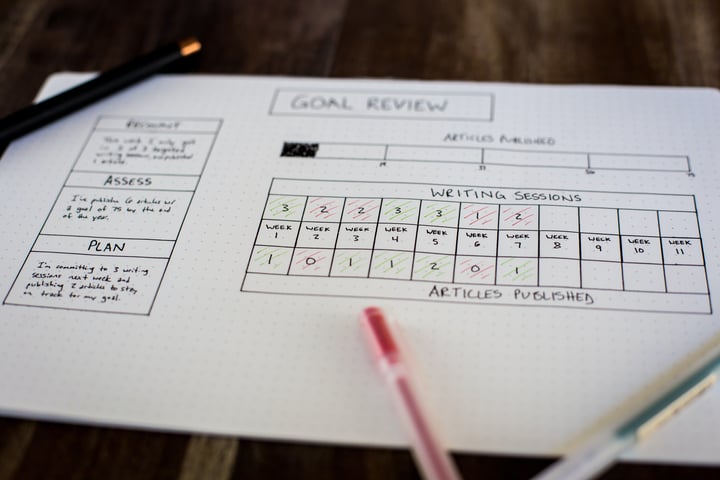Streamlining Your Sales Process: Mastering Pipeline Stages in HubSpot CRM
Efficiency and clarity in the sales process are not just beneficial; they are imperative. One of the critical components in achieving a streamlined sales process is the effective setup and management of pipeline stages within your Customer Relationship Management (CRM) system. HubSpot offers robust functionalities for managing pipeline stages. However, the true potential of these functionalities can only be unlocked with a meticulous setup that defines each stage's entrance, exit, and disqualification criteria. This blog post aims to guide you through setting up your pipeline stages in HubSpot, ensuring that your sales team can identify the correct stage, seamlessly progress deals without skipping stages, and timely move or disqualify deals from a stage.
Understanding Pipeline Stages
Before diving into the setup, it's crucial to grasp what pipeline stages represent in the context of your sales process. Each stage is a milestone in the journey of converting a lead into a customer. Properly defined stages provide visibility into this journey, enabling sales reps to understand precisely where each deal stands and what steps are required next.
Defining Entrance, Exit, and Disqualification Criteria
For a pipeline stage to function effectively, it must have clear entrance, exit, and disqualification criteria. These criteria ensure that deals are categorized accurately and that there's consistency in how sales reps manage them.
- Entrance Criteria: These are the conditions that must be met for a deal to enter a particular stage. Entrance criteria can include actions taken by the prospect, such as agreeing to a demo or providing necessary information for a proposal.
- Exit Criteria: These conditions determine when a deal is ready to move to the next stage. Exit criteria could involve the successful completion of a presentation or the prospect's agreement to a quote.
Disqualification Criteria: It's equally important to identify when a deal is no longer viable. Disqualification criteria help sales reps recognize when to remove a deal from the pipeline, ensuring that effort is focused on opportunities with a higher probability of closing.
Example pipeline stages
Sales pipeline stages for new business at B2B SaaS (Software as a Service) companies can vary based on the specific company's sales process and the complexity of the product/service being offered. However, here are some commonly used stages:
-
Prospecting/Lead Generation: This is the initial stage where potential leads are identified and gathered through various channels such as inbound marketing, outbound prospecting, advertising, networking, etc.
-
Qualification: In this stage, leads are evaluated to determine if they meet certain criteria that make them likely to become paying customers. This may involve assessing their needs, budget, authority to make purchasing decisions, and timeline.
-
Discovery/Demo: Once a lead is qualified, the sales team engages in a discovery process to understand the prospect's specific challenges, goals, and requirements. A product demonstration or presentation may also be conducted to showcase how the SaaS solution can address the prospect's needs.
-
Proposal/Quote: After the demo, the sales team provides a formal proposal or quote outlining the terms of the agreement, pricing, features, and any customization options. This stage may involve negotiation and addressing any objections or concerns raised by the prospect.
-
Negotiation: In this stage, the sales team works with the prospect to finalize the terms of the agreement, including pricing, contract duration, and any other terms and conditions. Negotiation may involve multiple rounds of discussions to reach a mutually beneficial agreement.
-
Closing: Once all terms are agreed upon, the prospect is ready to make a purchase decision. The sales team works to secure a signed contract or agreement and obtain any necessary approvals or signatures.
-
Implementation/Onboarding: After the deal is closed, the customer's account is set up, and the implementation process begins. This may involve configuring the SaaS solution according to the customer's specifications, providing training, and assisting with data migration if necessary.
-
Adoption/Usage: Once the customer is onboarded, the focus shifts to ensuring they effectively use and derive value from the SaaS solution. The sales team may provide ongoing support, check-ins, and assistance to address any issues or concerns that arise.
-
Expansion/Upsell: As the customer's needs evolve or they discover additional value in the SaaS solution, there may be opportunities to upsell or cross-sell additional products, features, or services.
-
Renewal: Prior to the end of the contract term, the sales team works to secure a renewal of the agreement. This may involve demonstrating the value delivered, addressing any concerns, and negotiating new terms if necessary.
These stages may vary slightly depending on the company's specific sales process, target market, and product/service offering. Additionally, some companies may have more granular stages or variations of these stages tailored to their unique needs and strategies.
One or multiple pipelines?
There are several reasons why B2B SaaS companies might structure their sales pipelines differently, including whether they include prospecting and renewal in the same pipeline or separate them into distinct funnels for upsells and renewals:
-
Complexity of Sales Process: In some B2B SaaS companies, the sales process for acquiring new customers and renewing existing contracts may be relatively similar in terms of effort and complexity. In such cases, it may make sense to have both prospecting and renewal stages within the same sales pipeline for a streamlined approach.
-
Resource Allocation: Companies with limited resources, such as smaller sales teams or those focusing on specific market segments, may prefer to consolidate their sales efforts into a single pipeline to maximize efficiency. This approach allows sales reps to manage both new business development and existing customer relationships within the same workflow.
-
Integrated Sales Strategy: Some B2B SaaS companies adopt an integrated sales strategy that emphasizes the lifetime value of customers. By keeping prospecting and renewal stages together, these companies can maintain a holistic view of the customer lifecycle and ensure consistency in their sales approach from acquisition to retention.
-
Revenue Forecasting and Reporting: Having prospecting and renewal stages within the same pipeline can facilitate more accurate revenue forecasting and reporting. Sales leaders can track the entire sales process from lead generation to contract renewal, providing better insights into revenue projections and performance metrics.
On the other hand, some B2B SaaS companies opt to separate prospecting from upsells and renewals for the following reasons:
-
Focus and Specialization: As a company grows, it may become beneficial to specialize sales roles based on different stages of the customer lifecycle. Separating prospecting from upsells and renewals allows sales reps to focus on specific tasks and develop expertise in their respective areas, leading to improved effectiveness and results.
-
Different Sales Dynamics: The sales dynamics involved in acquiring new customers versus upselling or renewing existing customers can vary significantly. Prospecting typically involves identifying and nurturing leads, while upselling and renewals may require a deeper understanding of the customer's evolving needs and relationship management skills. Separating these activities into distinct funnels allows for tailored sales strategies and resource allocation.
-
Sales Process Optimization: By creating separate pipelines for upsells and renewals, companies can implement customized sales processes and workflows that are optimized for each stage of the customer lifecycle. This approach enables greater flexibility in addressing the unique challenges and opportunities associated with upselling and customer retention.
Ultimately, the decision to combine prospecting and renewal in the same sales pipeline or separate them into distinct funnels depends on factors such as the company's sales strategy, organizational structure, customer lifecycle dynamics, and resource constraints. Each approach has its own advantages and considerations, and companies should evaluate their specific needs and objectives when designing their sales pipelines.
Setting Up Pipeline Stages in HubSpot
1. Navigate to Your Pipeline Settings: Log into your HubSpot account and access the sales pipeline settings. This area allows you to customize and manage your sales pipeline stages.
2. Define Your Stages: Start by listing the stages that reflect your sales process. Use descriptive names and ensure they are in the order that a deal would naturally progress through your sales process.
3. Establish Criteria: For each stage, define the entrance, exit, and disqualification criteria based on the explanations provided above. This specificity is crucial for maintaining a clear and efficient progression of deals through the pipeline.
4. Train Your Team: With the stages set, it's vital to train your sales team on the criteria for each stage. Ensure they understand the importance of maintaining the integrity of the process by adhering to these criteria.
5. Monitor and Adjust: Finally, regularly review your pipeline stages and criteria to ensure they continue to align with your sales process and market conditions. Be prepared to adjust as necessary.
By meticulously defining the entrance, exit, and disqualification criteria for each pipeline stage in HubSpot, you can significantly enhance the efficiency and clarity of your sales process. This approach ensures that sales reps can quickly identify the correct stage for each deal, navigate the pipeline stages without unnecessary delays or confusion, and recognize when a deal should be disqualified or moved out of a stage.
Optimizing your pipeline stages in HubSpot is not a one-time task but an ongoing process of refinement and adjustment. Start today by reviewing your current pipeline setup and identifying areas for improvement. Implement the strategies outlined in this post to ensure your sales process is as efficient and effective as possible. Remember, the goal is to provide your sales team with the clarity and structure they need to focus on closing deals and driving revenue.
For further assistance or to explore advanced techniques for optimizing your sales pipeline, feel free to connect with me. I support businesses with building their Sales process in the HubSpot CRM.





